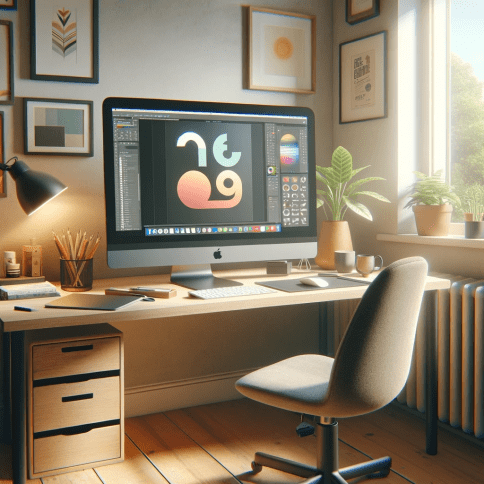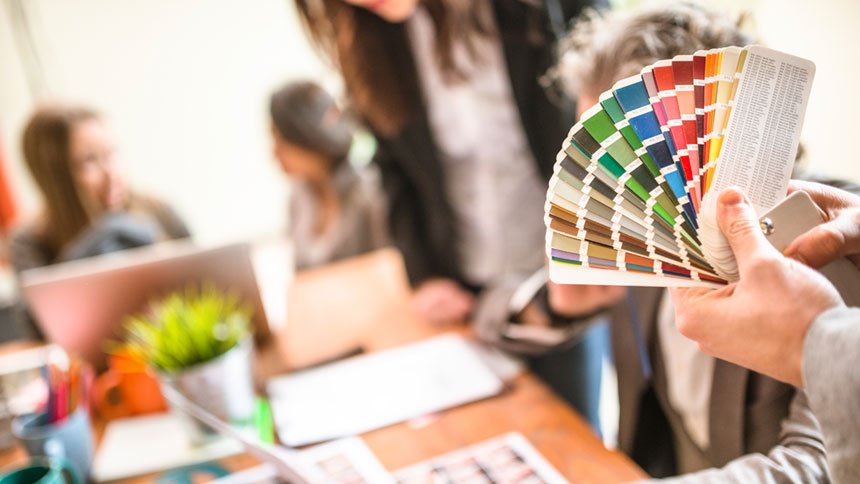You’ve got a thing for fonts, drool over drop caps, and go crazy for color, and you’re all about visual storytelling. You would rock at a graphic designer job. Check out what some actual graphic design professionals say about the job.
What exactly does a graphic designer do?
A graphic designer creates visual concepts to convey information through photos and art.
A graphic designer creates posters, bus wraps, billboards, packaging, logos, and marketing materials, depending on the industry—graphic designers work at magazines, advertising and marketing agencies, and more. The gig also includes selecting photos and typefaces and developing layouts for advertisements, annual reports, brochures, magazines, and other projects.
“A graphic designer does a range of things, depending on the type of company [she works] for,” says Kaitlin Mendoza, a graphic designer for Stampington & Company in Laguna Hills, California. Mendoza has her hands full editing photos, laying out copy, and choosing fonts for title treatments for the various magazines she works on. But she loves every minute of it. “I’m never bored at my job,” she says.

What skills are required?
The ability to design eye-catching visuals that are easily understood without much thinking is essential, says multimedia designer Alan Tabish, who designs and produces training materials as a graphic designer for management and technology consultancy Booz Allen Hamilton. He says experience with typography, color theory, and Web design is also helpful.
Flexibility is essential too, adds Mendoza. If the client’s vision doesn’t align with yours, you must make the necessary adjustments. And you have to be able to take criticism: Clients are vocal and sometimes indecisive. (Don’t take it personally.)
And you should be familiar with design software, especially Photoshop, Illustrator, and InDesign.
Are graphic designers’ skills and job responsibilities the same across the board, or do they vary according to industry?
In general, the same basic skills are required—staying on top of design trends and knowing how to take direction—but there are variations, says Mendoza.
As a magazine designer, Mendoza doesn’t have to develop logos and branding as a graphic designer at an ad agency likely would.
Tabish, whose clients are federal agencies, says there are differences in how you approach clients and deliverables. “Government folks tend to like simple graphics that clearly explain a process,” he says. He explains that many designs are similar to infographics, whereas design firms often let you take more risks.
Who is a graphic designer’s boss?
It depends on where you work. Mendoza reports to an art director, while Tabish reports to a project manager, who checks in with the client.
Are there other titles with similar responsibilities?
Graphic artists, production designers, and some web designers have similar responsibilities.
What do I need to get ahead as a graphic designer?
Keep your design skills sharp by regularly using different techniques. Earning certifications can also increase your on-the-job awesomeness.
How can I get my foot in the door?
Earning a BA in graphic design may make it easier to land your first job, but a degree isn’t required if you’re a talented designer skilled in Adobe Creative Suite.
But Tabish notes, “Without a college education, you’ll have better luck working at a design firm [because] government positions tend to require a degree.” Whichever route you choose, make sure you have a strong portfolio.
Graphic design trends to watch out for
With the rapid evolution of technology and the digital space, graphic design has seen many emerging trends. The landscape is always evolving from 3D design elements to monochromatic color schemes.
Staying updated with these trends is crucial for a designer to remain relevant in the industry. Additionally, with the rise of virtual and augmented reality, designers are now dabbling in creating more immersive user experiences.
The role of teamwork and collaboration in graphic design
Graphic design is not an isolated field; it thrives on collaboration and teamwork. Working effectively with team members is essential whether you’re part of a small studio or a large corporation.
Collaboration fosters creativity and innovation, allowing for the exchange of ideas and perspectives. It’s not just about working with fellow designers but also with professionals in related fields, such as marketing strategists, UX designers, and web developers.
The synergy between these roles can significantly enhance the effectiveness of visual designs, making them more appealing to the target audience.
The impact of a strong brand identity in graphic design
Understanding and contributing to a brand’s identity is crucial in graphic design. A graphic designer’s role often involves creating and maintaining a consistent visual language across various mediums – from product packaging to website design. This consistency is key to building brand recognition and loyalty.
Designers must deeply understand the brand’s intended message, target audience, and overall marketing strategy to create designs that resonate with consumers. This is where formal training, such as a bachelor’s degree in visual arts or a related field, can be incredibly valuable.
The evolution of graphic design skills and tools
The graphic design landscape continually evolves, demanding an ever-expanding skill set from designers. Mastery of traditional graphic design software like Adobe Photoshop, Illustrator, and InDesign is the starting point.
Today’s designers are also expected to be proficient in web design tools, understand basic programming languages like HTML and CSS, and even dabble in animation and video editing. Practical experience and formal training can provide a solid foundation in these diverse areas.
With the increasing video content consumption online, motion graphics have become a sought-after skill for graphic designers. Motion graphics can elevate a brand’s messaging and dynamically engage users for social media, websites, or digital advertising. Designers should consider learning software like After Effects to stay competitive.
Moreover, staying abreast of the latest software and tools is crucial, as they significantly shape design layouts and decorative effects.
Career pathways and opportunities in graphic design
A career in graphic design offers a plethora of paths and opportunities. From working in a design agency to freelancing, each path provides unique experiences and challenges. For those starting, internships can offer invaluable practical experience and a foot in the door of the workforce.
Additionally, joining professional organizations like the AIGA (American Institute of Graphic Arts) can provide networking opportunities and access to job openings.
Sites like the Bureau of Labor Statistics (BLS), Glassdoor, and Indeed often have up-to-date information on the average salary and market trends. Designers should also consider the type of work they enjoy, whether creating mockups and revisions for apps or developing signage and promotional materials. Each avenue requires graphic design skills, creativity, and technical knowledge.
The design world is constantly changing, and what’s trendy today might be outdated tomorrow. Continuous learning is crucial. This doesn’t just mean learning new design techniques but also understanding the industries you’re designing for. Attend graphic design workshops, take online courses, and join design communities to stay updated.
The importance of soft skills for a graphic designer
While technical skills are essential for a graphic designer, soft skills are equally vital. Effective communication is paramount, as designers often need to explain their concepts to non-designers. And asking the right probing question can make all the difference in understanding your client’s needs. Empathy helps understand client needs better, and problem-solving skills can turn a challenging brief into a successful design.
Furthermore, time management and handling stress are crucial, especially when working on tight deadlines. Speaking of tight deadlines, being able to tell a joke or two can also lighten the mood when in a crunch!
Sustainability trends in design
As businesses become more environmentally conscious, graphic designers must now think about sustainability in their designs. This could mean using eco-friendly materials for print designs or creating digital designs that use less energy. Awareness of the environmental impact of one’s design choices is becoming an essential aspect of the job.
Keeping an eye on diversity and inclusion
A diverse audience consumes designs, and they must resonate with everyone. Designers must be aware of cultural sensitivities and ensure their designs are inclusive. This might mean avoiding specific colors, symbols, or imagery that offend a particular group. Moreover, designers should advocate for diverse representation in their designs, ensuring that all groups are represented fairly and positively.
Deciding on freelance or agency
While some graphic designers prefer the stability of an agency or corporate job, others thrive as freelancers. Both have their pros and cons. Freelancing offers flexibility but comes with the challenge of finding clients and managing one’s own business. Agency work might deliver more consistent work but could be more structured. New designers should weigh their options and consider what suits their work style and life goals best.
Check out open graphic designer positions and other digital media jobs on Mediabistro’s job board.
FAQs about Graphic Designer Role
We’ve created a comprehensive set of frequently asked questions to discuss the role of a graphic designer in more detail. There is a lot to learn!
Q: What does a graphic designer do?
A: A graphic designer is responsible for creating visual concepts, using computer software or by hand, to communicate ideas that inspire, inform, and captivate consumers. They develop the overall layout and production design for advertisements, brochures, magazines, and corporate reports.
Q: How do graphic designers adapt their skills for virtual and augmented reality projects?
A: Graphic designers adapt to virtual and augmented reality by learning 3D modeling, understanding spatial design, and mastering interactive design software. These skills help create immersive and interactive experiences for VR and AR platforms.
Q: What role does data visualization play in contemporary graphic design?
A: In contemporary graphic design, data visualization is crucial for transforming complex data into understandable and visually appealing formats. It requires skills in information design, an understanding of data analytics, and the ability to create clear, compelling graphics.
Q: How are artificial intelligence and machine learning influencing graphic design?
A: AI and machine learning influence graphic design by automating routine tasks, providing data-driven design insights, and enabling the creation of personalized and dynamic designs. These technologies are revolutionizing how designers approach creativity and efficiency.
Q: What is the importance of user experience (UX) design in graphic design?
A: User experience (UX) design is becoming integral to graphic design, focusing on creating designs that are not only visually appealing but also user-friendly and intuitive. This involves understanding user behavior, designing for usability, and aligning visual elements with user needs.
Q: How can graphic designers effectively incorporate storytelling into their designs?
A: Graphic designers can incorporate storytelling by using visual narratives to convey a message or emotion, creating a connection with the audience. This involves strategically using imagery, color, and layout to tell a story that aligns with the brand or message.
Q: What are the ethical considerations regarding cultural sensitivity in graphic design?
A: Ethical considerations in graphic design include being culturally sensitive and avoiding stereotypes or offensive imagery. Designers must research and respect cultural norms and values, ensuring their work is inclusive and respectful of diverse audiences.
Q: How do graphic designers stay ahead in a rapidly changing digital landscape?
A: Graphic designers stay ahead in the digital landscape by continuously updating their skills, experimenting with new technologies and mediums, and staying informed about the latest design trends, digital tools, and industry practices.
Q: What is the impact of social media on graphic design?
A: Social media has a significant impact on graphic design, shaping design trends, enabling instant feedback, and requiring designers to create visually engaging and shareable content suitable for various social media platforms.
Q: How does typography play a role in modern graphic design?
A: Typography is a critical element in modern graphic design, as it influences readability, mood, and the overall effectiveness of the design. Designers must be adept at selecting and using typefaces that complement the design’s purpose and enhance the message.
Q: What strategies can graphic designers use to manage client expectations and feedback?
A: Graphic designers can manage client expectations and feedback by establishing clear communication, setting realistic timelines, presenting well-thought-out concepts, being open to constructive criticism, and educating clients about the design process.
Q: How does packaging design integrate with a brand’s overall graphic design strategy?
A: Packaging design is critical to a brand’s graphic design strategy. It involves creating visually appealing and brand-aligned packaging that communicates the product’s essence, attracts consumer attention, and reinforces brand identity. Designers must consider elements like color, typography, and imagery to ensure packaging consistency with the brand’s logo, marketing materials, and overall visual language.
Q: How does font selection play a role in creating effective brochures and marketing materials?
A: Font selection is crucial in brochure and marketing material design. The right font can enhance readability, convey the appropriate mood, and strengthen the message. Designers must choose fonts that align with the brand’s personality, target audience preferences, and the content’s purpose, ensuring the typography complements other design elements for cohesive and impactful communication.
Q: How is illustration utilized in modern graphic design, especially in digital media?
A: Illustration in modern graphic design, particularly in digital media, is a powerful tool to communicate concepts, tell stories, and evoke emotions. It adds a unique and creative dimension to design projects, enabling brands to stand out. Illustrations are used in website design, social media graphics, and digital advertising to create engaging and memorable visual experiences that resonate with the audience.
Q: What is the significance of certification for graphic designers in today’s job market?
A: Certification for graphic designers holds significant value in today’s job market. It demonstrates a designer’s proficiency in specific design tools or methodologies, such as Adobe Creative Suite or UX design principles. Certifications can enhance a designer’s credibility, increase their marketability, and provide a competitive edge in the workforce, especially for those seeking to specialize in certain areas of graphic design.
Q: How can graphic designers ensure their brochures effectively communicate with their intended audience?
A: Graphic designers can ensure their brochures effectively communicate with the intended audience by understanding their needs and preferences, using compelling visuals and clear messaging, and maintaining brand consistency. The design should be user-friendly, with a logical flow of information, eye-catching graphics, and a clear call to action. Testing designs with a target audience sample can also provide valuable improvement feedback.
Q: What trends shape the future of workforce-related graphic design, such as recruitment materials and company branding?
A: Trends shaping workforce-related graphic design include focusing on diversity and inclusivity, using bold and authentic imagery, and integrating digital and interactive elements. Recruitment materials and company branding increasingly leverage modern design aesthetics, storytelling, and digital platforms to attract a diverse talent pool and effectively communicate the company’s culture and values.
Q: How can a uniquely designed logo benefit a company’s branding and marketing efforts?
A: A uniquely designed logo benefits a company’s branding and marketing efforts by providing a distinct and recognizable symbol that embodies the brand’s identity and values. It helps build brand recognition, foster customer loyalty, and differentiate the company from competitors. An effective logo is memorable, versatile across various mediums, and resonates with the target audience, contributing significantly to the overall brand strategy.
Q: What does “Client Brief Interpretation” involve in graphic design?
A: Client Brief Interpretation involves understanding and translating client requirements into effective visual designs. It’s about grasping the client’s vision, objectives, and expectations, and creatively converting them into compelling graphic elements.
Q: How important are Project Management Skills for a graphic designer?
A: Project Management Skills are crucial for graphic designers to organize and manage design projects efficiently from start to finish. This includes planning, executing, monitoring, and closing projects, ensuring timely delivery and quality outcomes.
Q: Why is Print Production Knowledge important for graphic designers?
A: Print Production Knowledge is essential for understanding different printing processes and specifications. It enables designers to create designs that are not only visually appealing but also print-ready, ensuring high-quality physical outputs.
Q: What role does a graphic designer play in User Interface (UI) Design?
A: In UI Design, graphic designers focus on creating user-friendly and aesthetically pleasing interfaces for software and web applications. This involves designing layout, color schemes, buttons, icons, and other visual elements that enhance user experience.
Q: How do graphic designers integrate their work into Digital Marketing strategies?
A: Graphic designers integrate their work into Digital Marketing by creating visually engaging content that complements digital campaigns. This includes designing banners, social media graphics, email templates, and other digital assets that align with marketing objectives.
Q: What is the role of a graphic designer in Brand Strategy Development?
A: Graphic designers are instrumental in creating and implementing brand strategies. They develop visual identities that resonate with target audiences, including logos, color palettes, typography, and branding materials that communicate a brand’s values and message.
Q: How do graphic designers collaborate with copywriters?
A: Graphic designers work with copywriters to blend text and visuals effectively, ensuring that both elements complement each other to convey a clear and compelling message. This collaboration is vital in creating cohesive and impactful designs.
Q: What skills in Photography and Videography are beneficial for graphic designers?
A: Skills in Photography and Videography are beneficial for graphic designers to incorporate and edit photographic and video content into their designs. This adds a dynamic and engaging element to their work, enhancing the overall visual appeal.
Q: Why is understanding Cross-cultural Design Practices important for graphic designers?
A: Understanding Cross-cultural Design Practices is crucial for designing for diverse, international audiences. It involves being aware of cultural sensitivities, preferences, and norms, ensuring that designs are appropriate and resonate globally.
Q: What is Environmental Graphic Design and its significance?
A: Environmental Graphic Design involves creating designs that interact with architectural spaces. This includes wayfinding systems, murals, signage, and exhibit design, which enhance the user’s experience of a space.
Q: How do ethics play a role in the graphic design process?
A: Ethics in design address considerations like honesty, cultural sensitivity, and social responsibility. Designers must make ethical choices regarding content, representation, and sustainability practices in their work.
Q: Why is knowledge of Intellectual Property Rights important for graphic designers?
A: Understanding Intellectual Property Rights is vital for graphic designers to respect copyright laws, avoid plagiarism, and understand licensing issues. This ensures that their work and the work they use from others is legally compliant.
Q: What are the current trends in E-commerce Design for graphic designers?
A: Current E-commerce Design trends involve creating user-friendly, visually appealing online retail experiences. This includes understanding user behavior, using engaging visuals, and creating intuitive navigation to enhance online shopping experiences.
Q: How do graphic designers manage Client Relationship Management?
A: Graphic designers manage Client Relationship Management by building and maintaining strong relationships with clients. This involves effective communication, understanding client needs, and consistently delivering high-quality work.
Q: What is the Design Thinking Process and its relevance in graphic design?
A: The Design Thinking Process is a problem-solving methodology involving empathy, ideation, and experimentation. In graphic design, it helps in understanding the user’s needs and creating innovative, user-centric designs.
Q: Why are Responsive Design Techniques important in graphic design?
A: Responsive Design Techniques are important for creating designs that adapt to various screen sizes and devices. This ensures that designs are effective and visually appealing across different platforms, from desktops to smartphones.
Q: What involves Design Research and Analysis in graphic design?
A: Design Research and Analysis involve conducting research to inform and guide design decisions. This includes market research, user studies, and trend analysis, providing insights that shape effective and relevant designs.
Q: How do graphic designers engage in Cross-disciplinary Collaboration?
A: Graphic designers engage in Cross-disciplinary Collaboration by working with professionals from other fields, such as engineering or architecture, to create comprehensive design solutions. This collaboration brings diverse perspectives and expertise, enhancing the creativity and functionality of the design work.
Q: What are Sensory Design Elements, and how do they enhance graphic design?
A: Sensory Design Elements involve incorporating elements in design that appeal to senses beyond sight, like texture, sound, or even smell. These elements can significantly enhance the user experience, making designs more memorable and engaging.











